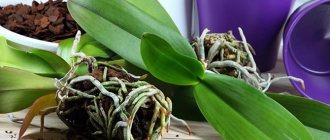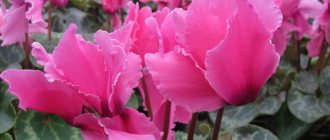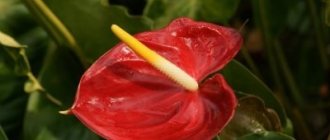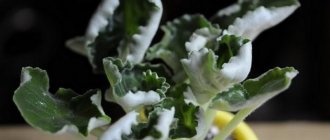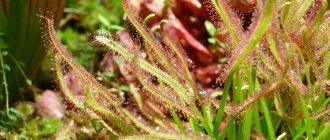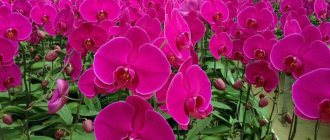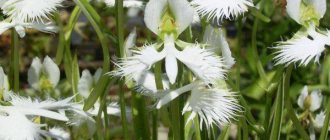Aphelandra (Aphelandra) - tall herbaceous shrub - a frequent luxurious “guest” of home greenhouses, originally from the American tropics.
Under home breeding conditions, the height of a representative of the Acanthus family reaches 30-70 cm. It is characterized by rapid growth of leaves and shoots (more than 4 per year). The lifespan of young plants is no more than 2 years.
It is distinguished by large spike-shaped inflorescences and dark green foliage with a waxy tint, topped with white or cream-colored veins.
Domestic flower growers are familiar with the perennial as a long-blooming domestic ornamental crop. The flowering phase occurs at the end of summer or beginning of autumn and lasts more than one month.
| High growth rate. In one year there are 6-7 new leaves. |
| It blooms in summer, but with high humidity it can bloom in winter. |
| Aphelandra blooms in summer. Flowers with yellow inflorescences. |
| Annual plant. Blooms for one year. Next, the plant is cut. |
Always decorative
Aphelandra is a representative of tropical flora, a moisture-loving and heat-loving flower of the acanthus family. It is grown as an ornamental leafy and ornamental flowering houseplant. This is a perennial subshrub or shrub with large contrastingly colored leaves, in nature reaching a height of two meters. Domestic aphelandras grow no more than 1–1.3 m, and for the most part they are lower, especially if you buy a compact variety.
Aphelandra sap is considered poisonous, so pruning and replanting is carried out with gloves.
The leaf plate of the flower is shiny, can be corrugated and smooth. The color is variegated: on the green surface of the leaf there is an ornament of white or silver stripes along the middle and lateral veins.
Aphelandra flowers are small, but the bracts are very decorative: they are bright and collected in the likeness of a faceted spike or pyramid 10–15 cm long. There are orange, yellow and red colors.
Aphelandra bracts are more decorative than flowers
The flower's homeland is considered to be South American and North American tropical rainforests.
It is considered to be a very finicky plant and requires a lot of effort to grow successfully. This is not entirely true: if you initially provide the aphelandra with optimal conditions for it, it will grow and delight you with its flowering.
Description
Aphelandra or Aphelandra (transcription from the Latin Aphelandra) is a genus belonging to the Acanthaceae family and includes 200 species of angiosperms. These are herbs, subshrubs and shrubs growing wild in the tropics/subtropics of Central and South America.
Home representatives of Aphelandra are low, beautiful bushes from 30 to 70 cm with straight stems. One of the main decorations of plants is large shiny oval leaves, located oppositely on the stem and having a smooth or prickly surface. On the dark green leaf plastic, fairly wide veins of white or yellowish color are clearly visible. Small flowers are collected in 4-angled spike-shaped inflorescences, while large and hard bracts of a contrasting shade enhance the decorative nature of the flowering. The color scheme of aphelandra depends on the species: the bracts can be green or all shades of yellow, and the color of the flowers varies from light yellow to scarlet and bright red. Flowering occurs from the second half of summer to September and lasts from 7 to 60 days, depending on the species.
Varieties for home cultivation
More than 170 varietal variations are found in nature. Only two species have adapted to be kept indoors - aphelandra protruding and aphelandra orange, however, the second species is extremely difficult to find on sale.
Aphelandra squarrosa can grow in a pot up to 130 cm, and this flower grows quickly, so most gardeners prefer to buy its more compact hybrids: Louise, Brockfield, Denmark.
Orange aphelandra (Aphelandra aurantiaca) is a low-growing shrub with a fleshy stem. As the plant matures, the trunk gradually becomes lignified. This type of aphelandra has large silvery-green leaves. The flowers are tetrahedral, bright orange. Flowering lasts about 7 days. The bracts and flowers of all varieties of aphelandra protruding are bright yellow . Under comfortable conditions, it blooms from June to November; on average, flowering lasts 6 weeks.
Photo gallery: aphelandra varieties for indoor keeping
The leaves of Aphelandra orange are silvery-green, without contrasting veins.
Variety Louise is a medium-height domestic shrub
If you are attracted to patterned leaves, choose the Fitz Prinsler variety.
The most compact varieties are considered Brockfield and Denmark
Video: compact aphelandra
Species diversity
At home, various species and varietal hybrids of aphelandra are usually grown, slightly different in appearance, but usually requiring the same care.
The following types are most popular in indoor culture:
- Protruding or Aphelandra Squarrosa is the most common in home floriculture. This is a compact shrub plant, no more than 50 cm high, with large leaves of deep green color, on which wide snow-white stripes located along the veins stand out in contrast, for which the flower is also called “zebra”. Small flowers of light colors fall off quite quickly, but the aesthetically attractive flowering effect is continued by bright bracts. Blooms for 1.5 - 2 months. The species is characterized by increased endurance and cold resistance, tolerating temperatures as low as 10°C.
- Orange is a low-growing evergreen flower, the juicy, thick and reddish stem of which becomes woody with age. The oval-oblong long leaf blades, pointed upward, have a silver-green hue, and the flowers with bracts are juicy orange. The flowering period is short - no more than 10 days.
- Retzlya is a cultivated variety that is distinguished by lush leaf cover with a predominance of white tones and long red-orange inflorescences. It blooms for about a week.
- Tetrahedral - a flower with large leaves and 15-centimeter inflorescences of a scarlet hue with green bracts.
- Sinclair is a taller species with rich green leaves, beautiful inflorescences and coral bracts.
In Russian interiors there are also other types of aphelandra, such as Denmark and Libon.
Aphelandra is a fast-growing plant. Over the course of a year, 5-6 new leaves grow on a young flower, and in the second year 4-5 new shoots appear.
How to Care for a Rainforest Guest
Growing aphelandra is quite difficult. It does not tolerate drafts and requires compliance with all maintenance rules. Violations of growing conditions can lead to deterioration in appearance or disease.
General conditions of detention by season - table
| Season | Temperature | Humidity | Watering | Lighting | Top dressing |
| Winter |
| Moderate | 1 time per week | Additional artificial lighting | Not required |
| Spring | About 20°C | Increased: frequent spraying | Generous, 2–3 times a week | Bright diffused light | Once every 1–2 weeks |
| Summer | 22–25°С | ||||
| Autumn | 18–20°С | Moderate | 1 time per week | Additional artificial lighting | Once every 1–2 months |
The nuances of watering and fertilizing
The flower requires regular and fairly abundant watering, especially in summer. It is important to ensure that water does not stagnate in the pot and tray, as this can provoke putrefactive processes. In the hot season, the soil should be well moistened, and in the cold it is enough to water as the earthen clod dries out. It is necessary to spray the leaves several times a day in summer, and once every 2-3 days in winter.
The plant requires regular mineral fertilizing, as the supply of microelements in the substrate is actively growing and quickly depleted. Fertilizers are applied once every 1–2 weeks during the period of active growth and vegetation. During the cold season, occasional feeding is carried out. Use complex fertilizers containing potassium, phosphorus and nitrogen.
During the period of active growth, fertilizers are used for ornamental leafy plants, and during flowering - for ornamental flowering plants.
Bloom
In indoor conditions, aphelandra usually blooms in early summer. A large inflorescence pleases for several weeks. Flower growers recommend removing it after flowering, since there is a possibility of getting a fruit, and in this case, after successful fruiting, the aphelandra may end its life cycle and wither.
In order to regularly observe the flowering of a tropical pet, it is necessary to give the flower a period of rest.
Rest period
The plant usually goes into rest mode immediately after flowering. From about mid-autumn to early spring, the flower is placed in a bright, cool room with an air temperature of 16–20°C. Carry out rare spraying and watering as the soil coma dries out. With the arrival of spring, the aphelandra is again moved to its permanent place.
Trimming
Due to active growth, the plant very quickly stretches out, loses its compactness and attractiveness, so it is worth pruning in a timely manner. Pinching the buds on the upper shoots of young specimens allows you to form a neat crown and add splendor. It is recommended to trim adult plants in early spring, removing up to half the length of the stems. After the pruning procedure, it is necessary to increase foliar spraying.
Aphelandra is a fast growing plant that requires pruning and shaping.
Transplanting a plant
In order for the plant to be healthy and strong, it is not enough to know how to care for aphelandra; it must be replanted every year. Since even an adult specimen does not require a large container of soil, replanting can be used to regulate the growth of an indoor specimen, as well as push the plant to form inflorescences.
When choosing ready-made soil or making your own soil mixture, it is important to remember that the crop feels best in a substrate with an acidity of 5.5 to 6.5. When caring for aphelandra, as in the photo, is carried out correctly, the plant grows quickly and constantly produces new healthy foliage.
- If the pH level is < 5.5, the leaves turn yellow and the formation of inflorescences and buds is disrupted.
- In soil with an alkaline reaction and pH > 7.0, aphelandra slows down its development and gradually dies.
To obtain a suitable soil, you can mix in equal parts:
- leaf soil;
- brown peat;
- washed sand.
It is easy to structure the resulting mixture if you add a little crushed charcoal, which also has an absorbent effect.
If the substrate turns out to be too dense, vermiculite is mixed into it. Sphagnum moss would be a good addition to the soil mixture.
Problem solving
Problems with aphelandra usually begin with improper care. They can manifest themselves in different ways, but if you do not respond to SOS signals, the flower will die very quickly.
This aphelandra was most likely kept in a cold draft
So, the main thing is to diagnose the cause of the deterioration in time and correct the shortcomings.
Maintenance errors and their elimination - table
| Problem | Cause | Elimination |
| Falling leaves | Insufficient watering | Adjust watering mode |
| Draft or low room temperature | Move to a warm place without drafts | |
| Plenty of bright sunlight | Cover or remove the plant from direct sunlight | |
| Lack of nutrients in the soil | Adjust the feeding mode | |
| Dry air | Spray the leaves every day, place the pot on a tray with wet drainage | |
| Wilting plant | Cold draft | Move the flower to another place |
| Brown leaf edge | Mold damage | Remove infected leaves and treat the plant with a fungicide according to the instructions. |
| Insufficient humidity | Spray the leaves every day, place the pot on a tray with wet sawdust | |
| Brown spots | Excessive amount of bright sun | Regularly ventilate the room or change the location |
| Lack of fresh air | Shade or rearrange the plant | |
| Shrinking of leaves | Lack of minerals | Adjust the feeding mode |
| Potty too tight | Transplant into a larger pot |
Thanks to its poisonous juice, this flower rarely gets sick, but overwatering is detrimental for it: fungal diseases - rot - can develop. In addition, a plant weakened by improper care loses its immunity and is easily attacked by pests.
Diseases and pests of aphelandra - table
| Source of damage | Signs of the disease | Prevention | Treatment |
| Shchitovka | Brown plaques and sticky drops on the leaf plate | Regular inspection and wiping of leaves with a damp cloth | One-time or weekly (in case of severe infection) treatment with chemical preparations Fitoverm or Actellik |
| Falling leaves | |||
| Mealybug | Whitish coating on leaves in the form of cotton wool | Wiping with soapy water followed by treatment with insecticides | |
| Aphid | Deformed tips of the sheet plate | Treatment with Akarin, Iskra Bio or infusions of plants with a pungent odor, such as wormwood | |
| Drying leaves | |||
| Insect colonies on leaves | |||
| Root rot | Roots darkened and softened |
| Surgical. Cut off the affected parts of the root system (if all the roots are affected, the plant cannot be saved), wash the remaining roots, sprinkle the sections with crushed coal and after a couple of hours transplant the flower into new disinfected soil with good drainage. |
| The leaves gradually turn yellow and wither |
Photo gallery: acanthus lesions
When aphids infest the plant, colonies of insects are clearly visible
Mealybug looks like a white cotton wool-like coating
When infested with scale insects, brown sticky spots appear on the plant.
A plant affected by rot stops growing and gradually withers
Parasites and diseases
The leaves become covered with dark spots. Necrotic spots on all parts of the flower are a symptom of the presence of gray rot.
How to solve this problem: immediately remove the infected parts and treat them with special chemicals.
Spots on the back of the leaves. This symptom may indicate that the plant is susceptible to infestation with scale insects.
We recommend reading: “Snapdragon Flower”
How to solve this problem: remove pests with a cotton swab or cloth soaked in alcohol. If the flower is not too big, you can also wash it with soap.
The presence of small former parasites on the flower. If small insects of a yellowish-white or greenish color were noticed, then we can say with almost 100% certainty that these are aphids.
How to solve this problem: treat the plant with specific pesticides, which can be easily purchased at a specialized center.
Reproduction
Aphelandra can be propagated in two ways: seeds and cuttings. The second option is more preferable, since after fruiting the mother plant often dies.
Seeds
Well-ripened seeds are collected and immediately sown in the substrate. A mixture of sand and leaf soil (1:4) is used as soil. For germination, create greenhouse conditions and a temperature of at least 25 degrees. The greenhouse needs to be ventilated every day for 20 minutes. The grown seedlings are planted in small pots.
Aphelandra seeds are about 5 mm in diameter
Cuttings
Vegetative propagation is a much more reliable and simpler method. Cuttings are carried out from March to May (less often in winter or summer). For this:
- Annual shoots up to 15 centimeters long are cut. They must have at least two leaves.
- The cuttings are treated with drugs that stimulate root formation: Atlet, Baikal EM-1, Kornevin and others.
- Rooting is carried out in a moist peat or sand substrate. Create a greenhouse environment by covering the pot with cuttings with film or glass.
One way to create a greenhouse is to place containers with plants in a transparent plastic container.
- The container with the cutting is placed in conditions with diffused light and a temperature in the range of 22–24°C.
- Ventilate the greenhouse for 10 minutes a day.
- Rooting occurs within 1–2 months. After this, they are transplanted into small pots and begin to be cared for like adult plants.
Aphelandra cuttings take up to two months to root
Temperature
As we have already mentioned, domestic aphelandra is quite capricious and requires some care. First of all, take care of the absence of drafts and compliance with temperature parameters.
For example, in winter, fifteen degrees of heat is enough, in the demi-season period - about twenty. During the summer months, keep the flower at about 24 degrees Celsius.
Reviews about growing aphelandra
I bought aphelandra in the spring, threw leaves all summer and eventually died. Although I like her, I won’t have her again. A very capricious plant.
raduzhnaya
https://forum-flower.ru/showthread.php?t=111
I had an aphelandra before, and I don't want to bother with it anymore. Even with high humidity it still doesn't feel right. Capricious, that's for sure. It also sheds its lower leaves all the time, and this is a natural process for it, so it needs to be renewed periodically. Well, it blooms normally and rests for the winter.
Cheremisova Galina
https://forum-flower.ru/showthread.php?t=111
A yellow flower in combination with green succulent leaves looks great, just to dilute the dull room atmosphere and add lively and bright flowers.
Adolf
https://rastimdoma.ru/content/afelandra
I thought that only my aphelandra was wasting away, but it turns out that this is her “birth illness”.
Alyonka
https://otvet.mail.ru/question/23135951
Trimming
Even “in captivity” aphelandra grows quite quickly, so it needs annual formative pruning. It is carried out at the end of winter, before the start of the intensive growth phase. In a young flower, it is enough to pinch the upper shoots by 2-3 buds to achieve greater splendor and “bushiness”.
Mature plants lose their decorative appearance, dropping their lower leaves, and the trunk becomes unattractively elongated. If pinching the upper shoots does not help, cut everything off, leaving “stumps” about 30 cm long. Then put a plastic bag on the pot, seal it tightly and leave the aphelandra in this form for 3-4 weeks, spraying it 2-3 times daily.
When this procedure does not give the desired result, the only way out is to cut off the apical cutting and re-root.
Common problems when growing aphelandra - table
| Description of the problem | Most likely causes |
| Withering and falling leaves | Insufficient watering. Even a short-term lack of moisture causes the aphelandra to shed its leaves. This may also be a consequence of low temperatures and/or the presence of cold drafts in the room. Most often, it is no longer possible to save the plant. Grow new things from cuttings. |
| The tips of the leaves turn brown, curl and dry out. | The air humidity in the room is not high enough. Spray the plant more often, place wet moss, peat, and expanded clay in the tray. Move the pot away from working radiators. |
| Individual sections of the leaf blade change color to brownish. | This is either a sunburn from direct sunlight on the leaves, or a consequence of insufficiently clean air. Ventilate the room more often. |
| The leaves become smaller, deformed, lose their brightness, and wither. | The reason is insufficient, excessive or incorrect fertilization. Examine the plant to determine which micro- and macroelements it is lacking. Do not exceed the concentration recommended by the manufacturer when preparing the solution. |
| Rot at the base of the trunk and leaves | Excessive watering. Increase the intervals between them and reduce the watering rate. Be sure to drain any excess water from the pan. If the plant is severely damaged, it is worth removing it from the pot and inspecting the roots for rot. In case of local damage, leaves with traces of rot are cut off, and the roots are given special attention during the next transplant. |
| The stem becomes thinner and longer, the inflorescence does not form or becomes deformed. | Aphelandra lacks light. Move it to where there is more sun, or use fluorescent lamps for additional lighting. |
